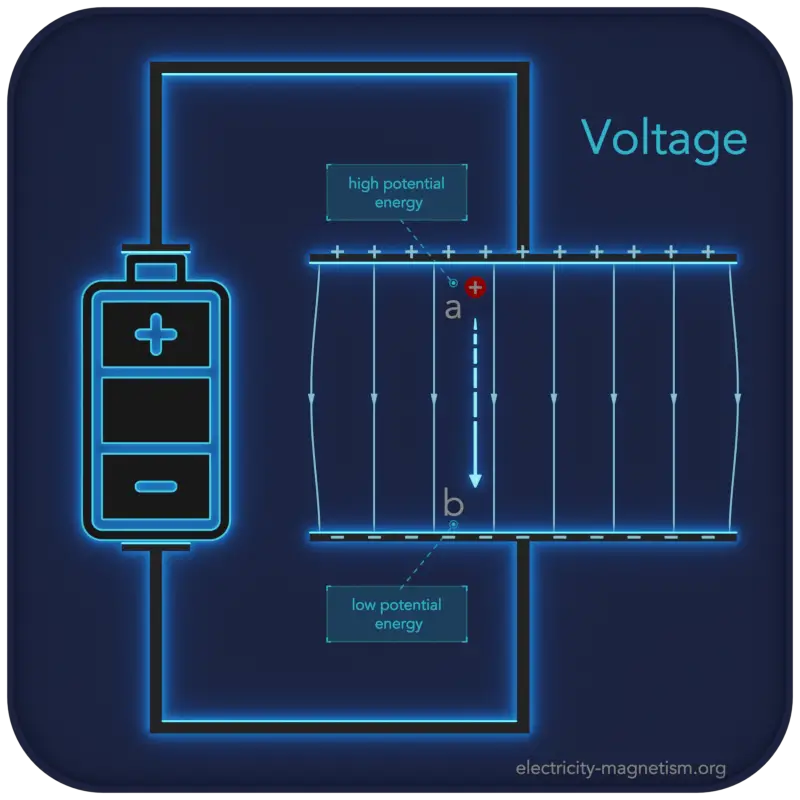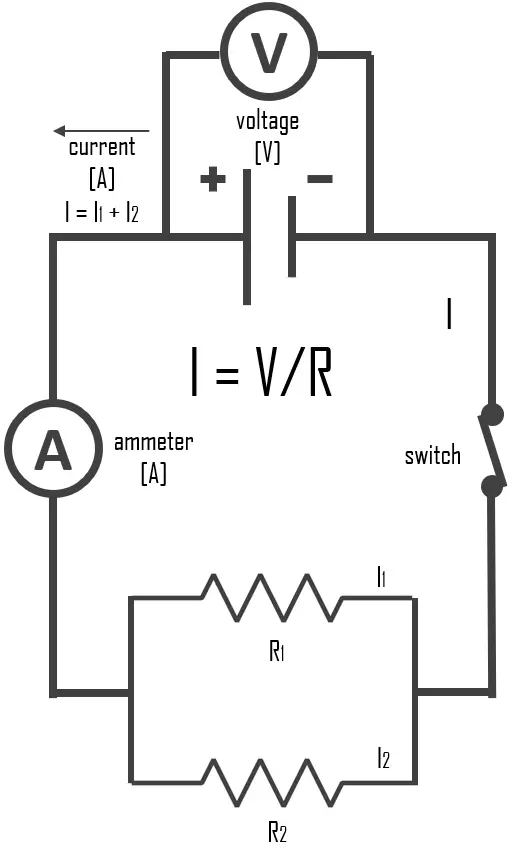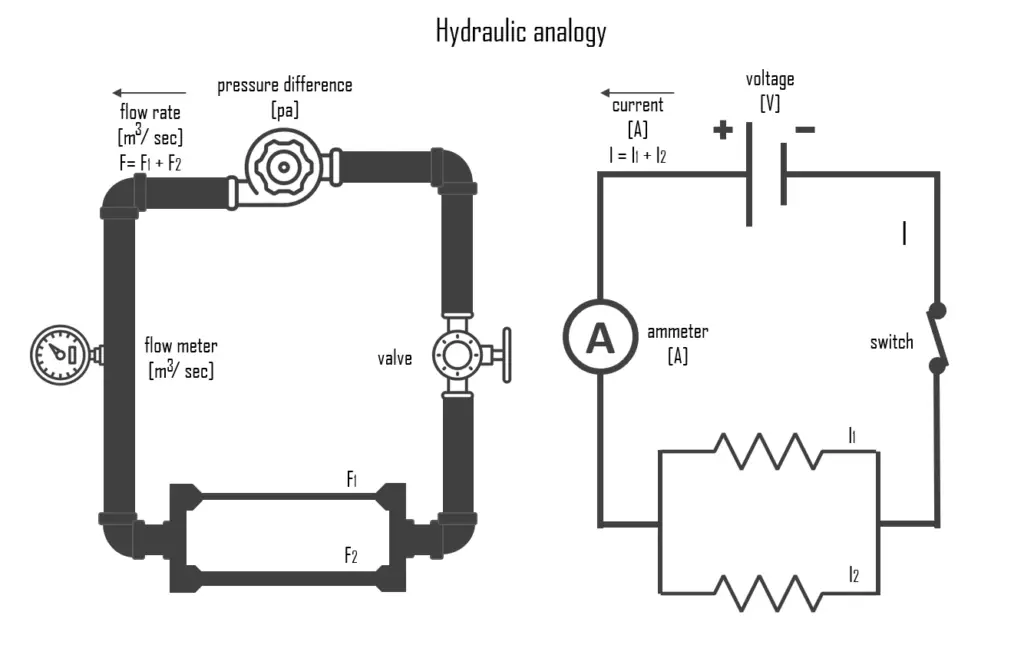30-second summary
Voltage
In physics, voltage is the difference in electric potential between two points.
Voltage, denoted by V, is defined as the amount of work energy needed to move a unit of electric charge from a reference point (a) to a specific point (b) in an electric field.
ΔV = Va – Vb
Voltage is also defined so that negatively charged objects are pulled towards higher voltages, while positively charged objects are pulled towards lower voltages. Therefore, the conventional current in a wire or resistor always flows from higher voltage to lower voltage. Ohm’s law states that one volt is the amount of force required to force one ampere of current through one ohm of resistance.

About Voltage
In physics, voltage is the difference in electric potential between two points. Voltage, denoted by V, is defined as the amount of work energy needed to move a unit of electric charge from a reference point (a) to a specific point (b) in an electric field.
ΔV = Va – Vb
In the International System of Units (SI), the electric potential is expressed in units of joules per coulomb (J⋅C−1), or volts (V). Although the concept of electric potential is useful in understanding electrical phenomena, only differences in potential energy are measurable. These differences in potential energy are measured with a voltmeter. Often a common reference potential such as the ground of the system is used as one of the points. A voltage can represent either a source of energy or the loss, dissipation, or storage of energy.

One coulomb is equal to 6.28 x 1018 (billion, billion) electrons. For example, if an object gains one coulomb of a negative charge, it has gained 6,280,000,000,000,000,000 extra electrons. A volt is defined as a difference of potential causing one coulomb of current to do one joule of work.
Voltage is also defined so that negatively charged objects are pulled towards higher voltages, while positively charged objects are pulled towards lower voltages. Therefore, the conventional current in a wire or resistor always flows from higher voltage to lower voltage. Ohm’s law states that one volt is the amount of force required to force one ampere of current through one ohm of resistance. The latter is the definition with which we will be most concerned.
Typical voltages
To help compare different orders of magnitude, the following list describes typical voltage levels.

- 1.5V (DC) – A common open circuit voltage for non-rechargeable alkaline batteries (e.g. AAA, AA, and C cells).
- 3.8V (DC) – Almost all smartphone batteries work at 3.8 volts. In order to make current flow from the charger to the battery, there must be a potential difference. Therefore battery chargers or USBs for almost all smartphones provide a voltage of 5V.
- 12V (DC) – A common voltage for automobile batteries is 12 volts (DC).
- 110 – 120V (AC) – The most common electrical outlet in any home. The American continent uses a voltage of 110 to 120 volts (AC) while Europe, Asia, and Africa use 220 to 240 volts (AC).
- 3kV – Voltage required to generate every 1mm of an electric arc. Air is a very bad conductor of electricity and has high dielectric strength. The dielectric strength of air is nearly 3000V/mm.
- 110kV – The voltage in electric power transmission lines used to distribute electricity from power stations can be several hundred times greater than consumer voltages, typically 110 to >500 kV (AC).
- 300 MV – A typical lightning flash is about 300 million Volts and about 30,000 Amps.
Methods of producing voltage – Electric potential generation
The voltage, or the electric potential, can be produced by the following methods:
- Static electricity – Most of the static electricity we encounter every day is caused by the triboelectric effect. The charging of a solid object by rubbing can be explained by the transfer of electrons from one object to the other. This can easily be produced by rubbing two dissimilar materials together, such as rubbing amber with fur or glass with silk.
- Electrochemistry – Chemicals can be combined with certain metals to cause a chemical reaction that will transfer electrons to produce electrical energy.
- Magnetic induction – Rotating coils of wire through a stationary magnetic field or by rotating a magnetic field through a stationary coil of wire produces an electric potential.
- Piezoelectric effect – Bending or twisting certain materials will cause electrons to drive out of orbit in the direction of the force. When the force is released, the electrons return to their original orbit.
- Thermoelectricity – Heating two joined dissimilar materials will cause a transfer of electrons between the materials setting up a current flow.
- Photoelectric effect – The photoelectric effect is the emission of photoelectrons from a material matter when electromagnetic radiation (photons) hits its surface.
- Thermionic emission – Freeing electrons from a hot surface causes electrons to escape.
Volt – Unit of Voltage – Definition
The volt is the derived unit for electric potential, electric potential difference (voltage), and electromotive force. In the International System of Units (SI), an electric potential is expressed in units of joules per coulomb (J⋅C−1), or volts (V). The volt is named after the Italian physicist Alessandro Volta (1745–1827).
One coulomb is equal to 6.28 x 1018 (billion, billion) electrons. For example, if an object gains one coulomb of a negative charge, it has gained 6,280,000,000,000,000,000 extra electrons. A volt is defined as a difference of potential causing one coulomb of current to do one joule of work.
Voltage – Hydraulic Analogy
The hydraulic analogy, or the electric-fluid analogy, is a widely used analogy between hydraulics and electricity, which is a useful tool for teaching and for those who are struggling to understand how circuits work. it can also be applied to heat transfer problems.
Since electric current is invisible and the processes in play in electronics are often difficult to demonstrate, the various electronic components are represented by hydraulic equivalents. The relationship between voltage and current is defined (in ohmic devices like resistors) by Ohm’s law. Ohm’s Law is analogous to the Hagen–Poiseuille equation, as both are linear models relating flux and potential in their respective systems.
Electricity (as well as heat) was originally understood to be a kind of fluid, and the names of certain electric quantities (such as current) are derived from hydraulic equivalents.
- Voltage is like the pressure difference that pushes water through the hose. It is measured in volts (V). This model assumes that the water is flowing horizontally so that the force of gravity can be ignored.
See also: Hydraulic Analogy

Frequently asked questions
Although the concept of electric potential is useful in understanding electrical phenomena, only differences in potential energy are measurable. These differences in potential energy are measured with a voltmeter.
Primary cells gradually drop in voltage from use; they start at 1.5 volts, drop to 1.2 and continue to 1.0, where the appliance stops working. Secondary cells operate more uniformly even with only 1.2 volts; they have flat discharge where they pretty much stay at 1.2 volts until depleted and then drop off very quickly to below 1.0 volts.
1.5V (DC) – A common open circuit voltage for non-rechargeable alkaline batteries (e.g. AAA, AA and C cells).
3.8V (DC) – Almost all smartphone batteries work at 3.8 volts. In order to make current flow from the charger to the battery, there must be a potential difference. Therefore battery chargers or USBs for almost all smartphones provide a voltage of 5V.
12V (DC) – A common voltage for automobile batteries is 12 volts (DC).
110 – 120V (AC) – The most common electrical outlet in any home. The American continent uses a voltage of 110 to 120 volts (AC) while Europe, Asia and Africa uses 220 to 240 volts (AC).

